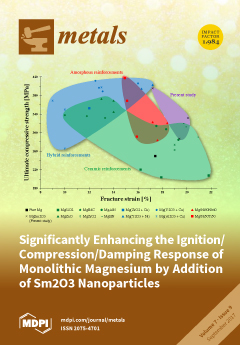The present study reports the development of Mg–Sm
2O
3 nanocomposites as light-weight materials for weight critical applications targeted to reduce CO
2 emissions, particularly in the transportation sector. Mg-0.5, 1.0, and 1.5 vol % Sm
2O
3 nanocomposites are synthesized
[...] Read more.
The present study reports the development of Mg–Sm
2O
3 nanocomposites as light-weight materials for weight critical applications targeted to reduce CO
2 emissions, particularly in the transportation sector. Mg-0.5, 1.0, and 1.5 vol % Sm
2O
3 nanocomposites are synthesized using a powder metallurgy method incorporating hybrid microwave sintering and hot extrusion. The microstructural studies showed dispersed Sm
2O
3 nanoparticles (NPs), refinement of grain size due to the presence of Sm
2O
3 NPs, and presence of limited porosity. Microhardness and dimensional stability of pure Mg increased with the progressive addition of Sm
2O
3 NPs. The addition of 1.5 vol % of Sm
2O
3 NPs to the Mg matrix enhanced the ignition temperature by ~69 °C. The ability of pure Mg to absorb vibration also progressively enhanced with the addition of Sm
2O
3 NPs. The room temperature compressive strengths (CYS and UCS) of Mg–Sm
2O
3 nanocomposites were found to be higher without having any adverse effect on ductility, leading to a significant increase in energy absorbed prior to compressive failure. Further, microstructural characteristics are correlated with the enhancement of various properties exhibited by nanocomposites.
Full article





